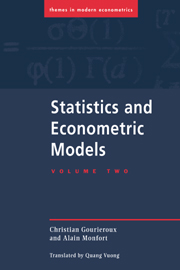Book contents
- Frontmatter
- Contents
- 14 Introduction to Tests of Hypotheses
- 15 Uniformly Most Powerful Tests
- 16 Unbiased Tests and Invariant Tests
- 17 Likelihood Based Tests
- 18 General Asymptotic Tests
- 19 Multiple Tests
- 20 Set Estimation and Confidence Regions
- 21 Inequality Constraints: Estimation and Testing
- 22 Nonnested Models
- 23 Asymptotic Efficiency
- 24 Asymptotic Theory
- Review of Linear Algebra and Matrix Calculus
- Review of Probability
- Index
18 - General Asymptotic Tests
Published online by Cambridge University Press: 04 August 2010
- Frontmatter
- Contents
- 14 Introduction to Tests of Hypotheses
- 15 Uniformly Most Powerful Tests
- 16 Unbiased Tests and Invariant Tests
- 17 Likelihood Based Tests
- 18 General Asymptotic Tests
- 19 Multiple Tests
- 20 Set Estimation and Confidence Regions
- 21 Inequality Constraints: Estimation and Testing
- 22 Nonnested Models
- 23 Asymptotic Efficiency
- 24 Asymptotic Theory
- Review of Linear Algebra and Matrix Calculus
- Review of Probability
- Index
Summary
In the previous chapter we have considered tests based on the likelihood function. Such tests can be used when the model is parametric, i.e., when the family of probability distributions defining the statistical model is indexed by a finite dimensional parameter. Moreover, we have assumed that this family contains the true probability distribution having generated the observations. When such assumptions are deemed too stringent, it is necessary to apply other testing procedures.
In Section 1 we shall consider the case where the unconstrained and constrained estimators of the parameter vector θ of interest are obtained via a maximization of a general statistical criterion Ln(θ). In addition, we shall consider the case where the null hypothesis is under the so-called mixed form (See Section 10.1). The resulting framework is quite general. It contains as a special case the theory developed in the previous chapter, which relied upon the likelihood function and a null hypothesis in either implicit or explicit form. In Section 2, we shall study specification tests based on asymptotic least squares. In Section 3 we shall consider specification tests based on generalized methods of moments. These estimation methods were introduced in Chapter 9. In Section 4 we shall apply the general principle underlying Hausman tests to the present framework. Such a principle was introduced in Section 17.9 within a likelihood context. Lastly, in Section 5 we shall present the so-called information matrix test.
Tests Based on an Estimation Procedure Defined by a General Objective Function
We consider the framework of Section 10.3.1. The parameter of interest is θ ∈ θ ⊂ Rp.
- Type
- Chapter
- Information
- Statistics and Econometric Models , pp. 135 - 178Publisher: Cambridge University PressPrint publication year: 1995



